#because they are all unique and none are reverse image of any other symbols
Explore tagged Tumblr posts
Link
"From the start, this process has involved a certain impulse of the soul away from its first organic, local shelters and toward more abstract citadels of certitude. With this, inevitably, has come a certain estrangement from life. Hence this impulse has often expressed itself as the pursuit of a wisdom that transcends the world, a quest for release or moksha, a contemptus mundi that frequently becomes a neurotically fastidious fear of being touched. The impulse reaches an extreme expression in those virtuosos of despair whom the developed religions regard as holy or wise or uniquely illumined. These are souls for whom the absolute exaltation of a single incorruptible principle of spiritual “truth” is a call to unremitting remorse, a measureless psychic labor of repentance, a search for ultimate release only in a realm beyond the triviality of common humanity. The mystic in a state of fused contemplation has returned to something like that aboriginal, intra-uterine state of “floating”—but now in the “womb” of the One God, which is the most impregnable sphere of immunity imaginable.
(...)
The Christian story brings this history to one of its epochal watersheds. In the Gospel there is a radical assault upon all the mediating structures of patriarchal authority—all the religious and social institutions, all the established offices of pedigree and privilege, all the nested stations of kin, people, kingdom, empire, and priesthood—by the individual soul’s claim of an immediate filiation to the One God. For Sloterdijk, Christ is “God’s bastard,” the Father’s natural child, as it were, conceived and born outside all legitimate lines of inheritance and all licit structures of authority. And his anti-patriarchal revolt became in time a license granted to every soul: now each of us, in our individual humanity, liberated by this social and spiritual apostasy, can become God’s bastard too, someone in whom God directly dwells as Father. At the same time, and by the same logic, a new order of social and political desire was implanted in human nature: that of “infinite egalitarianism,” a passage from the psycho-politics of command and obedience to one of equal self-determination, the transformation of vertical into horizontal difference.
Here again Sloterdijk’s favored image is exorcism, which should be understood, he believes, as a kind of purification of a sacred space, a cleansing of the Temple. The soul was once conceived “neither as a theater nor as a factory, as is typical of the modern age, but rather as a sanctuary in which no image was allowed to be on display except that of the god-man—whose image, in turn, had to represent an indescribable God.” In driving out the more elemental spiritual forces that once reigned with such capriciousness in nature, society, and the soul, the One transcendent principle of the Axial Age also became the source of a sovereign selfhood. This is because the expulsion of evil spirits from the soul had to be completed by the subsequent “entrance of a bright principle, which, as warden of the purified soul, became its new monitor and source of inspiration.” The soul thus underwent a change of possession: now it was the Spirit of God himself that was at work within it.
This purification of the self’s inner precincts may have been a thoroughly religious experience, but it was also a crucial episode in the history of Enlightenment, and thus of secularization. For, when that most elevated of sheltering spheres finally shattered—as it had to do—the sovereign self became the sole remaining sanctuary of whatever mysteries might be left. All the other possibilities of shelter had been successively exhausted, and had then been assumed into that ultimate transcendence, and had finally disappeared with it.
(...)
In any case, the old pieties and enchantments are irretrievable. With no God to watch us, there really is no sin to be resolved before his gaze, and so no power that can reconcile us to, or rescue us from, indecipherable fate. The modern human being wants not to obey a higher power but to be that power. As soon as God and the soul had been liquidated, we were left with only the world as a brute event. In this “hyper-immanent” space, a purposeless energy idly unfolds around us, with no fingerposts to guide us across the featureless terrain. The world has truly become a monster to us, and we, far from finding shelter in any redoubtable spheres of co-immunity, discover only that the controlled exodus toward final freedom that was promised to us by the myth of Enlightenment has proved instead to be a precipitate slide toward social and ecological disintegration, psychic vagrancy, and what Sloterdijk calls an unsheltered “heteromobility.”
(...)
Sloterdijk identifies three kinds of immune system that he regards as necessary for human existence: the biological (naturally), the social (which consists of solidarity and shared support), and the symbolic or ritual (which grants human beings power from higher sources whenever they feel themselves to be powerless). The third of these has been weakened irreparably by secularization and individualism, while the second has been subjected to continuous dilutions and dissolutions. We still have not discovered any efficient system of co-immunity for the global society that is now emerging, or devised any new shelters against the monstrosity of a world of empty fate.
(...)
Rather than an attempted retreat into an irrecuperable past, what Sloterdijk believes we really require is a new sphere of solidarity that can encompass all life, a shelter strong enough to create a robust co-immunity for the defenseless whole: global society, animal and vegetal life, nature, the earth itself. Religion has been irretrievably lost as a binding system of values, so we need a new piety devoted to, and sustained by, the oneness of the earth that we inhabit, share, and depend on. As far as Sloterdijk is concerned, moreover, the history of revelation—if one may use that word—has continued to the present day, and there are many things we have learned on the way to modernity, such as the nobility of the individual soul’s “proud” search for a system of personal freedom. These are lessons we must not forsake or let ourselves forget if we are to create a habitable future. For him, they constitute a “Newer Testament.”
(...)
What might Christians make of any of this story? Why should they care? Well, to begin with, they should acknowledge that Sloterdijk, in confirming Nietzsche’s diagnosis of God’s death in the developed world, is doing nothing more than stating an evident fact of history. The disappearance of that transcendent horizon of meaning and hope within whose commodious embrace just about all persons and cultures once subsisted is simply a fait accompli. The frantic extremism of the fundamentalisms and religious nationalisms and crypto-fascist integralisms of our current moment poignantly attests to the inconceivability for late modern culture of a God who is anything other than the construct of either the will to power or a desperate emotional need. None of them is a true sign of a revival of faith; all of them are only the hideous contractions of a deepening rigor mortis. And inasmuch as the genuinely living Christianity of the past was the vital wellspring of “Enlightenment” in the Western world, the departure of that Christianity from Western culture has carried away all those earlier possibilities of “co-immunity” that it had summed up in itself.
Epochs of the spirit are not reversible, or even susceptible of recapitulation. This is an Hegelian insight that no one should doubt: great historical and cultural transitions are not merely ruptures, but also moments of critique. The rationality of history lies in the ceaseless triumph of experience over mere theory, and so in the impossibility of any simple return to pre-critical naïvetés. Sooner or later, just about every cultural economy is defeated by its own inner contradictions, barring interruption of this natural process by a sudden foreign conquest. And the new order that succeeds it is probably no freer from contradictions of its own, which will be exposed in their turn. More to the point, every cultural order’s collapse is also the exhaustion of the synthesis that that culture embodied. Innocence yields to disenchantment, and disenchantment cannot revert to innocence.
Certainly this has proved so in the case of Christendom and its sequel, secularization. The Christendom of the empire or the nation state, being an alloy of two ultimately irreconcilable principles, inevitably subverted itself. It persisted for as long as it did by virtue of a genuinely organic cultic devotion with a durable practical and theoretical infrastructure. But its inherent contradictions ultimately destroyed that basis. The language and principles of the Gospel frequently illuminated the society that cherished them; the offices and powers of the state consistently sheltered, preserved, and advanced the religion that legitimated them. But the alliance was a suicide pact. The most devastating solvent of Christendom, in the end, was the ineradicable presence of Christianity within it. The corrosive force most destructive of Christianity as a credible source of social order was in the end the crushing burden of Christendom upon it.
(...)
As for the liberal secular order that succeeded Christendom, its own inner stresses and volatilities are all too obvious. In the economic realm, it has created prodigies of material production and destruction, as well as forms of power and oppression on a scale formerly unimaginable. In the social realm, it has created ceaseless struggles among incompatible visions of the good while providing no clear transcendent index of values for adjudicating their conflicts. For better or worse, it has eliminated or marginalized almost all mediating or subsidiary forms of social agency and reduced meaningful social order to the interdependent but necessarily antagonistic claims of the state, capital, and the sovereign individual. And Sloterdijk is quite right: under such conditions, we have little defense against the ecological and social calamities that we have created for ourselves. So, again, given these realities, what ought Christians to do?
Certainly, what they should not do is indulge in sickly nostalgias and resentments, or soothe their distempers with infantile restorationist fantasies. History’s immanent critique has exposed too many of the old illusions for what they were, and there can be no innocent return to structures of power whose hypocrisies have been so clearly revealed. There are any number of reasons, for instance, for dismissing the current vogue of right-wing Catholic “integralism”: its imbecile flights of fancy regarding an imperial papacy; its essentially early-modern model of ecclesial absolutism; its devotion to a picture of Christian social and political order that could not be any less “integralist” or any more “extrinsicist” and authoritarian in its mechanisms; the disturbingly palpable element of sadomasochistic reverie in its endorsement of various extreme forms of coercion, subjugation, violence, and exclusion; the total absence of the actual ethos of Christ from its aims; its eerie similarity to a convention of Star Trek enthusiasts gravely discussing strategies for really establishing a United Federation of Planets. But the greatest reason for holding the whole movement in contempt is that it is nothing more than a resentful effort to reenact the very history of failure whose consequences it wants to correct. Secularity was not imposed upon the Christian world by some adventitious hostile force. It simply is the old Christendom in its terminal phase."
2 notes
·
View notes
Text
http://nymag.com/intelligencer/amp/2019/10/the-full-case-for-trump-impeachment.html?__twitter_impression=true
The (Full) Case for Impeachment
A menu of high crimes and misdemeanors.
By Jonathan Chait | Published October 14, 2019 | New York Magazine | Posted October 15, 2019 |
The crimes for which impeachment is the prescribed punishment are notoriously undefined. And that’s for a reason: Presidential powers are vast, and it’s impossible to design laws to cover every possible abuse of the office’s authority. House Democrats have calculated that an impeachment focused narrowly on the Ukraine scandal will make the strongest legal case against President Trump. But that’s not Trump’s only impeachable offense. A full accounting would include a wide array of dangerous and authoritarian acts — 82, to be precise. His violations fall into seven broad categories of potentially impeachable misconduct that should be weighed, if not by the House, then at least by history.
I. Abusing Power for Political Gain
Explanation: The single most dangerous threat to any democratic system is that the ruling party will use its governing powers to entrench itself illegitimately.
Evidence: (1) The Ukraine scandal is fundamentally about the president abusing his authority by wielding his power over foreign policy as a cudgel against his domestic opponents. The president is both implicitly and explicitly trading the U.S. government’s favor for investigations intended to create adverse publicity for Americans whom Trump wishes to discredit. (2) During his campaign, he threatened to impose policies harmful to Amazon in retribution for critical coverage in the Washington Post. (“If I become president, oh do they have problems.”) He has since pushed the postmaster general to double rates on Amazon, and the Defense Department held up a $10 billion contract with Amazon, almost certainly at his behest. (3) He has ordered his officials to block the AT&T–Time Warner merger as punishment for CNN’s coverage of him. (4) He encouraged the NFL to blacklist Colin Kaepernick.
II. Mishandling Classified Information
Explanation: As he does with many other laws, the president enjoys broad immunity from regulations on the proper handling of classified information, allowing him to take action that would result in felony convictions for other federal employees. President Trump’s mishandling of classified information is not merely careless but a danger to national security.
Evidence: (5) Trump has habitually communicated on a smartphone highly vulnerable to foreign espionage. (6–30) He has reversed 25 security-clearance denials (including for his son-in-law, who has conducted potentially compromising business with foreign interests). (31) He has turned Mar-a-Lago into an unsecured second White House and even once handled news of North Korea’s missile launch in public view. (32) He gave Russian officials sensitive Israeli intelligence that blew “the most valuable source of information on external plotting by [the] Islamic State,” the Wall Street Journal reported. (33) He tweeted a high-resolution satellite image of an Iranian launch site for the sake of boasting.
III. Undermining Duly Enacted Federal Law
Explanation: President Trump has abused his authority either by distorting the intent of laws passed by Congress or by flouting them. He has directly ordered subordinates to violate the law and has promised pardons in advance, enabling him and his staff to operate with impunity. In these actions, he has undermined Congress’s constitutional authority to make laws.
Evidence: (34) Having failed to secure funding authority for a border wall, President Trump unilaterally ordered funds to be moved from other budget accounts. (35) He has undermined regulations on health insurance under the Affordable Care Act preventing insurers from charging higher rates to customers with more expensive risk profiles. (36) He has abused emergency powers to impose tariffs, intended to protect the supply chain in case of war, to seize from Congress its authority to negotiate international trade agreements. (37–38) He has ordered border agents to illegally block asylum seekers from entering the country and has ordered other aides to violate eminent-domain laws and contracting procedures in building the border wall, (39–40) both times promising immunity from lawbreaking through presidential pardons.
IV. Obstruction of Congress
Explanation: The executive branch and Congress are co-equal, each intended to guard against usurpation of authority by the other. Trump has refused to acknowledge any legitimate oversight function of Congress, insisting that because Congress has political motivations, it is disqualified from it. His actions and rationale strike at the Constitution’s design of using the political ambitions of the elected branches to check one another.
Evidence: (41) Trump has refused to abide by a congressional demand to release his tax returns, despite an unambiguous law granting the House this authority. His lawyers have flouted the law on the spurious grounds that subpoenas for his tax returns “were issued to harass President Donald J. Trump, to rummage through every aspect of his personal finances, his businesses and the private information of the president and his family, and to ferret about for any material that might be used to cause him political damage.” Trump’s lawyers have argued that Congress cannot investigate potentially illegal behavior by the president because the authority to do so belongs to prosecutors. In other litigation, those lawyers have argued that prosecutors cannot investigate the president. These contradictory positions support an underlying stance that no authority can investigate his misconduct. (42) He has defended his refusal to accept oversight on the grounds that members of Congress “aren’t, like, impartial people. The Democrats are trying to win 2020.” (43) The president has also declared that impeachment is illegal and should be stopped in the courts (though, unlike with his other obstructive acts, he has not yet taken any legal action toward this end).
V. Obstruction of Justice
Explanation: By virtue of his control over the federal government’s investigative apparatus, the president (along with the attorney general) is uniquely well positioned to cover up his own misconduct. Impeachment is the sole available remedy for a president who uses his powers of office to hold himself immune from legal accountability. In particular, the pardon power gives the president almost unlimited authority to obstruct investigations by providing him with a means to induce the silence of co-conspirators.
Evidence: (44–53) The Mueller report contains ten instances of President Trump engaging in obstructive acts. While none of those succeeded in stopping the probe, Trump dangled pardons and induced his co-conspirators to lie or withhold evidence from investigators. Former Trump lawyer Michael Cohen testified to Congress that Trump had directed him to lie to it about his negotiations with the Russian government during the campaign to secure a lucrative building contract in Moscow. And when Cohen stated his willingness to lie, Robert Costello, an attorney who had worked with Rudy Giuliani, emailed Cohen assuring him he could “sleep well tonight” because he had “friends in high places.” Trump has publicly praised witnesses in the Russia investigation for refusing to cooperate, and he sent a private message to former national-security adviser Michael Flynn urging him to “stay strong.” He has reinforced this signal by repeatedly denouncing witnesses who cooperate with investigators as “flippers.” (54–61) He has exercised his pardon power for a series of Republican loyalists, sending a message that at least some of his co-conspirators have received. The president’s pardon of conservative pundit Dinesh D’Souza “has to be a signal to Mike Flynn and Paul Manafort and even Robert S. Mueller III: Indict people for crimes that don’t pertain to Russian collusion and this is what could happen,” Roger Stone told the Washington Post. “The special counsel has awesome powers, as you know, but the president has even more awesome powers.”
VI. Profiting From Office
Explanation: Federal employees must follow strict rules to prevent them from being influenced by any financial conflict. Conflict-of-interest rules are less clear for a sitting president because all presidential misconduct will be resolved by either reelection or impeachment. If Trump held any position in the federal government below the presidency, he would have been fired for his obvious conflicts. His violations are so gross and blatant they merit impeachment.
Evidence: (62) He has maintained a private business while holding office, (63) made decisions that influence that business, (64) and accepted payments from parties both domestic and foreign who have an interest in his policies. (65) He has openly signaled that these parties can gain his favor by doing so. (66) He has refused even to disclose his interests, which would at least make public which parties are paying him.
VII. Fomenting Violence
Explanation: One of the unspoken roles of the president is to serve as a symbolic head of state. Presidents have very wide latitude for their political rhetoric, but Trump has violated its bounds, exceeding in his viciousness the rhetoric of Andrew Johnson (who was impeached in part for the same offense).
Evidence: (67) Trump called for locking up his 2016 opponent after the election. (68–71) He has clamored for the deportation of four women of color who are congressional representatives of the opposite party. (72) He has described a wide array of domestic political opponents as treasonous, including the news media. (73–80) On at least eight occasions, he has encouraged his supporters — including members of the armed forces — to attack his political opponents. (“I have the support of the police, the support of the military, the support of the Bikers for Trump — I have the tough people, but they don’t play it tough until they go to a certain point, and then it would be very bad, very bad.”) (81) He has threatened journalists with violence if they fail to produce positive coverage. (“If the media would write correctly and write accurately and write fairly, you’d have a lot less violence in the country.”) (82) There have been 36 criminal cases nationwide in which the defendant invoked Trump’s name in connection with violence; 29 of these cited him as the inspiration for an attack.
#trump scandals#trumpism#president donald trump#trump administration#ivanka trump#donald trump jr#trump2020#news today trump#donald trump#president trump#trump#impeach45#impeach trump#impeachment inquiry now#impeachthemf#impeachtrump#impeach4peace#impeach him#impeachnow#impeachtheloser#impeachable#maga#maga2020#politics and government#us politics#politics#u.s. news#u.s. constitution#u.s. military
8 notes
·
View notes
Text
The Fantasy Adventure Trope and Autistics.
Currently I am fascinated with narrative framing. The structure of a story and how that gives us the meanings that we draw from it.
What I have noticed is that neurodivergent consciousness isn't taken into consideration very often. In fact many narratives, especially in children's literature and films have a gaslighting affect when it comes to the experiences of neurodivergent children.
Children who are different are portrayed as having an overactive imagination, big emotions or too reserved, shy, afraid, a little adult, low impulse control, not very social, bullied at school and are ignored by adults.
This jumble of traits pretty much fits most neurodivergents. But just enough so that they are endearing and don't seem "too weird".
Unfortunately many children are thought of in the same vein as the biblical prodigal son. Disabilities and difficulties are seen as trials to be fixed, or to fix "us" as if we need some form of chastising.
That our ways are wrong and we choose to bring difficulty on ourselves by not ignoring the things everyone else ignores and doing what everyone else does.
People expect neurodivergent children to be doormats and when they are shoved into that role they naturally become distressed and hide or rebel.
Such children then go on a magic adventure, where they learn about who they are as a person and then return home better off than when they left, able to cope and function better in their world.
That's a very general idea of the plots of most magic adventures. And there's nothing wrong with that, if indeed that is what is occurring.
But too often it is not. Most of these narratives portray the child as in need of a rude awakening, again with the prodigal image, spoiled, lack of discipline, bad attitude, needing to burn off energy, needing confidence, needing change over all.
And how this occurs is through what is known as exposure therapy. A theorized technique where non-biological anxiety is reduced through exposure to the source of the anxiety.
This does not work on neurodivergents nor many with trauma related conditions. It only serves to burn out energy and destroy our nervous systems and peace of mind if we had any to begin with.
The adventure supposedly leads the child to become used to physical stress, work and decision making. It assumes that the child has had no trauma or stress before this. That their difficulties came from being uncooperative with adults. What it comes down to is that it is the child that needs to change, not their world.
And what that means for the neurodivergent child whose experience of the world can not change through a change in attitude, is that they are made to feel flawed, that unlike the "good" children in those stories, they are bad.
Which leads them to hiding their difficulties and masking. And if they are autistic, the feeling of being nonhuman increases significantly.
*On a side note: Fantasy gives neurodivergent traits to majority non-human characters. I really do enjoy fantasy but the characters I related to most were the non-humans or the villain, and both.
There are a lot of non-human characters that should just have been human. When only "make believe" species have your sensitivity and traits, it makes it very hard for people to take you seriously. That's a whole other article though.*
Back to narrative:
Two examples come to mind. The German novel "The Neverending Story" by Michael Ende and and the Japanese film "Spirited Away" by Hayao Miyazaki.
These were big impact stories, I'm only going to cover 3 items from each.
Someone with more energy can dig in deeper. Also if the plots sound really similar to you, children going off into fantasy worlds and receiving help from dragons, it is because Michael Ende loved Japan and was inspired by Japanese folklore.
His second wife is Japanese and his stories became huge in Japan where he toured and gave lectures and was honoured with his own museum shortly before he passed away.
First, The Never Ending Story.
Yes, the story with Bastian, Atreyu, the child-like empress and my personal favourite, Falcor the luck dragon. Who doesn't love the ending of the film version where he scares the shit out of those bullies as he chases them into the dumpster?
There are a lot of very good things in this story, Bastian fits completely the profile of the neurodivergent child,but for those who have read the book there are some glaring details, and Yes, I know all the other interpretations and cultural symbolism going on.
But I'm looking at these from an autistic perspective, being as personal and literal as possible. Because that is how I viewed them and many others will, as a kid and teenager.
1. Despite Bastian's trauma from school and his mom's death it is up to him to fix his emotionally shut down father.
There's a new term for this, emotional incest. Google that. Emotionally Bastian has a lot going on,he and his father should really be seeing a therapist.
This topic can be controversial as it crosses into many cultural expectations of what a family is and the required roles within a family. There are various levels of toxicity that can occur in parent child relationships that result in anger later on in the child. But a parent relying on a child for emotional support is seen as the most benign.
One could say that is traditionally what children are for. From the outside pushing back at this role looks like "modern selfishness" but the inside reality is that the stress placed on a child who needs support and understanding themselves is damaging. When suppressing growth for a parent, the child does not learn to become an emotionally healthy adult.
For many neurodivergents this can look like carer abuse, infantalisation, a parent guilt tripping for all the work they do for the child. Expecting full loyalty to a parent with punishments imposed for perceived infractions.
Demanding all of a child's time. Not allowing friends, becoming jealous of online friends, hobbies, and anything that takes their attention away from the parent.
Given that as adults many disabled neurodivergents rely on their parents for support, these relationships remain complex and complicated.
2. Spending too much time in your inner world makes you less human.
For those not familiar with the second half of this book, for every wish and fantasy Bastian lives out he loses his memory and humanity. WTH?
As someone who has memory and dissociation issues this really freaked me out and made me question whether or not my dissociation, frequent need to retreat and loss of self at times was due to me being a bad, selfish person like the townspeople in the book.
Autistics and other neurodivergents have rich inner worlds that are just as real as what is going on outside them.
They are a part of this world as nature, and it is there that we often find and preserve our sense of self instead of getting lost in a sea of others.
Without them we would lose ourselves. Our humanity should never be equated with how much we outwardly participate.
3. Bastian wasn't capable of being loved before his journey.
When Bastian loses his humanity he nearly kills Atreyu but is stopped. He repents by working hard in a mountain, as a miner where he loses the last of himself, including his name in order to learn selfless love.
Hard stare. Really? Neurodivergents tend to be born selfless it seems, and we have really hard times creating boundaries for ourselves in how much we will give others and are much too open to manipulation because of it.
In my mind Bastian is already doing far too much emotional labour for a child to sustain and shouldn't be required to have to work on top of that for love to be given him.
More messages towards us about being selfless only harms us and makes us feel guilty for not draining ourselves dry for others.
Reiterating again, that Esoterica and symbolism, metaphors etc...are my special interest, I know what the esoteric symbolism of all this is but most children will not and Will take this aspect literally.
Overall none of his physical issues such as Body positivity, the school and bully situation nor any other issues were addressed. His real fear was part of his "overactive imagination" that he had to overcome.
This gaslights many neurological disabilities and experiences with the world, where synesthesia, sensory processing differences and executive Dysfunction are labelled imaginary and trauma around them is exasperated.
Spirited Away
This is the film that inspired this. Because I loved this. Miyazaki truly knows how to capture the soul of nature.
Some back story about anime you truly need to know before we move on.
If you're autistic, and fan of Anno Hideki creator of Evangelion, also a fellow autistic, who also worked with studio Ghibli, then you probably know what he means when he stated that anime and manga are an inherently autistic medium.
Paraphrasing Anno:
Your goal is to reach out and connect with others deeply and emotionally.
The main way this is achieved is having the emotional interior of people reversed, showing every emotion externally.
In anime all the huge feelings, trauma and anxiety that usually go on inside someone are shown on the outside. This makes it really relatable and easy to connect emotionally to the characters.
Big secret though, non-neurodivergents assume a lot of the emotions are exaggerated and the trials and stages the characters go through are metaphors.
If you are neurodivergent, you know they are not. Many things are literally what is happening to us on the inside, how certain things feel.
I'll give examples when I talk about Spirited Away, but if you are further curious, Google Newtypes from the Mobile Suit Gundam saga and Evangelion.
This unique feature and style, of emotions began in the Tokugawa Era as a form of non-violent rebellion against the imposed socially rigid caste system and militarism of the era that saw creativity as superfluous.
Anything different, mysterious, unknown, imaginative and emotional did not meet the new "social norms" of the shogunate era and were rejected.
Artists and writers, the creative castes, started making woodblock prints of fantasy scenes and stories in a style now known as manga.
They kept Non-linear, neurodivergent thought and ways of being alive during that violent time period when many creators were imprisoned.
Ok, with that on to Spirited Away. I'm going to focus on Autistic masking. Masking plays a huge role in this story.
Briefly, the plot is: 10 year old Chihiro, on the way to her new home is spirited away with her parents. Going against her instincts she follows them into what turns out to be the holiday and pleasure district of the gods.
Her parents eat the god's food, turn into pigs and Chihiro must then sell herself to the onsen ( bath house) in order to work off the debts of her parents and save them.
The main characters that I personally relate with in this piece are Haku, the dragon boy/river god, the Faceless Spirit/Noh Face and the witch Zeneba.
So again, 3 things.
1. Masking, Chihiro is The Mask.
Chihiro, the cool, collected,lovely mixture of innocence and maturity is the mask that many autistic women grew up wearing in order to handle trauma. Be strong, brave and stoic for the sake of others. This is one set of strong messages that the film puts out.
In the bridge scene where Haku and Chihiro, under an invisibility spell, cross the bridge to the bathhouse; in order to cross without being seen Chihiro must hold her breath.
That is what Autistic masking literally feels like, the fear of being seen, caught and punished for who we are and the sharp pain of inhaled breath held, for too long, and slow suffocation.
Chihiro's journey will feel familiar to many young autistics who are learning about themselves and the people around them and how they fit into the social structures here. Chihiro is a foreigner and awkwardly trying to stay out of trouble.
There isn't a structure that fits her. She's scolded and hindered for simply existing in that space not meant for her. But she has a task to complete, so she has to figure out a way to make things work.
Being survival, task and mission oriented is a strong point of being Autistic. It's part of our ability to be perseverant.
It can be so strong that your mind creates different ways of being to hide and protect the most sensitive parts of itself, to protect the parts that are different.
Chihiro's final line in the film is:
"Don't worry, I think I can handle it."
She's resolute in her maintaining a stoic mask, which is implied as part of growing up. This message is toxic to Autistics
For a lot of us Autistics this line recalls childhood trauma and masking. The exact phrase we would say to "make things work" for ourselves. Suppressing our needs in order to appear mature and keep our parents and those around us comfortable.
If the bathhouse is supposed to represent life and the social- economic reality, then it's the same reality so many face, forced to change and pretend they fit into society. This message about masking feels at odds with the "re-discovering your true self" message that we get with Haku.
The river dragon spirit, Haku literally represents what masking your true self can look like. Under Yubaba he loses sense of his true nature, physically grows pale and steely eyed. He isn't conscious of the spell Yubaba has placed in him. Masking isn't conscious to a lot of Autistics either.
As an apprentice Haku carries out orders no matter what the danger is to himself. Putting ourselves in harm's way and being abused without us knowing is an outcome of masking. When masking we are in the position of copying others feeling very much like "apprentice non-autistics".
We want to please in order to survive and feel adequate with others. In the scene when Haku is bleeding to death and Yubaba kicks him into the incinerator to be disposed of, that unfortunately is a real emotional outcome to many abusive relationships built through masking. Relationships fail once we burn out.
In order to show his true nature, Haku actively fights inside himself when helping Chihiro. He plays double agent throughout the film. And then has to be saved from himself by Chihiro.
Do I need to be saved from myself?
Do I seem as cold and distant as Haku?
Am I and my masking setting a bad example, a burden to seemingly purer people like Chihiro who haven't quite learned to mask yet?
These questions flitter and linger for a long time. There's a pang of sadness in them.
It's an extremely complicated issue which is further complicated when navigating personal boundaries and what is felt to be personally owed to others, it changes with each situation.
During the train scene when Chihiro is given time to process her predicament you can literally see her mentally forming her mask, the mask that's prepared to take responsibility for others mistakes.
It's the same mask we create to carry the burden of being social and appropriate when no one else is, the mask that self blames and takes up energy. Chihiro takes responsibility for everything.
There is again that message of sacrificing your well being for others that is pushed. She is the only one actively trying to save both her parents and Haku.
Being a heroine doesn't have to be about saving others, or being responsible for them, especially when they are capable of finding their own solutions. There are so many different ways to show love and support.
It isn't about being selfish and just taking care of yourself, for many Autistics and those with multiple disabilities, caring for others in this manner isn't an option but feeling guilty for not doing this is a constant to many.
Who this message is being directed to, needs to change. It should not be directed at vulnerable girls or any children who will worry and have anxiety about themselves.
The reality of many situations where change is needed from someone in authority, parent or any other institution is that it fails to occur. Children or other exploited parties are made responsible for that failure.
If an Autistic fails to fit in, it's never societies fault, the burden of change and guilt is always put on the autistic. And in order to shoulder it, masking occurs. How long is she going to be able to keep up that tough girl facade?
2. Home
In the opening of the film Chihiro is upset at what would honestly be devastating for someone who relies on "their world" to make sense of who they are. Moving, no home to return to. This concept literally is played out with Haku and Noh Face.
Haku's river is destroyed, because of this he loses his identity and falls prey to those who would enslave him. An identity that changes with physical environment is common. Some autistics, like myself, unconsciously build an identity or mask that fits specifically to our environment.
Environment becomes routine along with all of the sensory stimulus and sensitivity, our bodies physically bond to what is comfortable to us. And when that changes, so does a whole persona or personality mask.
When it is an unexpected and forced change, it is traumatizing. In my own experience, I've moved 10 times in a single year at the age of 14. Only 4 years older than Chihiro.
That caused a shutdown that I'm still experiencing the effects of 20 years later. Losing those connections is never a matter of letting go and moving on. They are grieved and must be processed at length.
On the way out of the forest Chihiro's father notices how quiet she is, both parents finally are paying attention to the emotional reality of their child. If they had listened and paid attention to her intuition, warnings and signs of trauma, in the beginning, their predicament would not have occurred. They might not have even moved in the first place.
"A new home and school, it is a bit scary," her father says. To which Chihiro replies that she can now handle it.
Chihiro, suppressing her original concern and the trauma of her experience, now gaslights herself, after she's gone through the process of learning how to perform emotional and mental labour for others through masking as an act of love.
An act of love, that's how mainstream society positions suppressing the needs of the disabled. You're told if you love your parents, your family, don't cause problems, don't cause trouble.
Oh, your having trouble at school, at work, at home? Disabilities are framed as trouble in this manner, the same way one speaks of a misdemeanor or crime. It subtlety shifts feelings of fault and blame onto the disabled. When it comes to Autistics the way we understand our self and our experience of the environment is often blamed as the cause of troubles.
For us the Non-autistic world is assaulting both physically and emotionally. It's a mess of social and psychological mind games and head traps that make us chronically ill. We have to create our own environments to dwell and recover in each night.
For a large proportion of us, we experience time and space Non-linearly. Which means events are not chronological, they don't neatly line up in our minds.
Our experience of the world is like the concepts of Ukiyo and Yugen. Transience, ethereal and profound depth of feeling. Events, people, places float in and out with moments of deep joy and sadness to help us make sense of time.
Miyazaki makes full use of this narrative tradition in his storytelling with vast spaces and characters who on the surface are only loosely associated with each other yet deeply connected.
In our world connection is not linear, nor emotions. Associative thinking leads us to make broad connections in ways that branch out and lead us to discoveries that seem impossible or were unknown to many because the right associations couldn't be made in their linear minds.
Non-linear emotions mean that we don't process events as they happen. It's too much to take in, emotions float in us, incubating until they are ready to be understood. The moment this happens is usually triggered by seemingly unconnected events but to which our minds have made connections to, enough to bring us to full circle. Different mental processing times mean reactions and effects come later, long after expected.
3. Noh face. Portraying other as grotesque.
The best for last.
Noh face as in the Noh theatre, because the mask they wear, delights and troubles in it's accurate yet disturbing qualities. The spirit does not speak except to make pleading utterances. The faceless spirit is sad, mysterious, interesting,terrifying and revolting all at once.
When it is invited into the bathhouse it begins to eat several of the workers and gains the ability to speak and their personality traits.
It is one of the most grotesque and extreme moments in the film. It can make you squirm. But it's also the most literal example of what it can be like to mask.
There is a certain type of masking that occurs for autistics who also experience dissociation, derealisation and depersonalisation.
It's the least understood and most vital to understand; this is how the brain involuntarily forces command or auto-pilot, for survival in situations it deems life threatening.
When around other people these autistics physically feel themselves absorb the energy, the personalities, emotions and desires of other people, so much so that it overwhelms their mind/ soul, their identity and sense of who they are.
They can lose track of where they are and what they say and do ; literally becoming "drunk" on other people, acting erratically or hyper with a loss of inhibition.
They may do and say things they wouldn't have before and never would alone, when caught in the energy of the crowd or moment. And often they can't quite remember what occurred until afterwards. It's an uncomfortable and frightening experience to not be in control, to feel like a slave to others wills .
With this type of masking the autistic may be aware of it or might not be, but they are not in control of when it happens or with who. It occurs on a daily basis this absorption of personas and others traits. It's chaotic inside, an ever changing kaleidoscope of thoughts and feelings that are almost never your own.
Physically, after socialising, especially if it's from a party, when this type of autistic is alone, people hangover sets in.
People hangovers, even though I don't drink that's the best definition I have of it, you feel ill enough that you vomit; as you would expect with all of this swirling chaos.
The only way to end it is to sleep it off as you psychologically purge all the fragments of others out. This is another physical sensation as you feel yourself emptying and regaining control. This process can feel like being scrubbed raw, internally.
This masking isn't done out of "loneliness" as is the reason given by the Noh Face. But having no one to understand and going through this alone, does build up and can increase the feelings of desperation to have a stable self.
In the scene when Chihiro gives the Noh face the expectorant, and they vomit just as Haku did, as all the people they consumed left, they returned to their original small form, no longer able to speak.
Chihiro, in that scene is the only one with boundaries, she masks her fear and listens, using her knowledge to give the Noh Face what they really need. She presents a kind, calm and stable force that counters chaos.
It's no wonder the Noh Face wants to absorb her. She's the ultimate mask that it can then have to feel whole and interact with others finally.
But it still would not be their own.
On a side note, it is for this very reason that Noh Face is finally paired with the witch Zaneba, whose line "hmmm, what else can we mess with?" is my favourite. Zaneba sees the structure of the bathhouse and wants to disrupt it.
Due to the chaos occurring inside these type of autistics, instead of trying to order life in a structured or "tidy" way, they impose chaos externally. As long as it is their chaos, this ordered chaos approach is effective in coping with life.
Roles, duties and tasks bring about more structure than superficial order as in the bathhouse. If there's a specific function and purpose that is clear, it makes it easier to not mask, which is why the noh face is able to remain calm.
At the end of the day Zaneba and Noh Face retreat to their quiet home, where function and roles are simple. Personally that's where I'd like to stay, if I were Chihiro I wouldn't have returned.
That's a final point, the "fantasy" world is always made out to be lesser than our shared reality. But is it really? Our inner worlds are what make it possible to survive in the outer world. It's where we process and draw strength to combat the hostility we encounter daily.
They aren't something you abandon in childhood, but a necessary life skill that develops further with age. The fantasy retreat is vital for rest and reclamation of self from society. Not something to be left behind.
So there you have it. My rough autistic sense on what messages an autistic/neurodivergent might take away from popular story narratives and elements in children's fiction and film.
#critical analysis#creative writing#creative#actuallyautistic#actually autistic#fantasy#narative#long reads#long post#essay#neurodivergent#neuroqueer#neurodiversity#synesthaesia#symbolism#spirited away#the neverending story#children#asd#pda#dissociation#autistic acceptance#autistic culture#autistic masking
33 notes
·
View notes
Link
NOBODY KNOWS WHAT LUXURY IS ANYMOREBy
Marc Bain
June 16, 2018
Luxury ain’t what it used to be. Blame the internet, the rise of on-demand services, and the shift in consumer values as younger generations become more important buyers of high-end goods—all are challenging traditional notions of what luxury is.
The classic symbols—the Hermès Birkin bag, a couture dress by Dior, a watch by Rolex—aren’t in any danger of losing status. But around its edges, the concept of luxury is getting blurry, making it less clear where it begins and ends.
What, for example, should you make of a Louis Vuitton hoodie created in collaboration with a skate brand? Is a $2,500 dress still a luxury item when you’re renting it for a fraction of that price? Does the shine of luxury fade if you get a bargain on used coat and then resell it a few months later? Does a New Yorker tote bag rival pricey handbags by signaling an exalted sensibility?
These questions aren’t just hypotheticals. Luxury labels are turning to sweatpants and sneakers for sales growth. The designer clothing rental company Rent the Runway is spreading across the US. Online resale sites such as The RealReal and Vestiaire Collective keep growing. And social and environmental awareness has become a potent marker of affluence and status.
The changes are forcing the traditional luxury makers to adapt, particularly as a new normal of slower global growth takes hold. They’re also offering opportunities for success to the designers and businesses ready to capitalize on the transformations taking place.
Here’s what we know about the new luxury, gleaned in part from insights shared by luxury insiders at a June 7 conference organized by the French-American Chamber of Commerce (FACC) in New York.
LUXURY IS A GRAPHIC T-SHIRT
“The idea of what is luxurious is changing; I think it’s about brand rather than luxury,” said Lazaro Hernandez, cofounder of American fashion brand Proenza Schouler, at the conference.
One of the clearest themes to emerge from the event, which brought together executives from several French and American businesses to talk about the shifts taking place in the industry, was that even for them it’s becoming harder to define what counts as luxury.
Hernandez and Jack McCollough, Proenza Schouler’s other cofounder, argued that an exquisitely crafted product��one of the pillars of traditional, aspirational luxury—matters less to young shoppers than it did to previous generations. More often today it’s the brand—the image, and the storytelling—that attract, which means luxury brands can often sell non-luxurious products without any damage to their prestige.
“I think a true luxury brand today can work in so many different price points,” Hernandez continued. “You can sell a t-shirt for $300, $200 and still be considered a luxury brand these days. Those parameters of what is considered luxury and what is not, I think, are sort of disappearing.”
While fashion and luxury aren’t one in the same, as menswear critic Charlie Porter has astutely noted, many leading luxury brands have followed consumers toward less formal dress, which these days means a lot of athletic wear, especially sneakers, and casual, logo-heavy streetwear. Louis Vuitton hired fashion designer Virgil Abloh, known for his streetwear leanings, to design its menswear. Balenciaga’s creative director, Demna Gvasalia, has found success with items such as sneakers and hoodies.
No matter how expensive and well-crafted they are, a Balenciaga t-shirt or a pair of its sneakers would not have generally been called luxurious a few decades ago—especially as they can be deliberately ugly, reflecting the desire of designers and shoppers alike to break from old standards of taste and stand out on Instagram (paywall). But as Gvasalia told the Financial Times (paywall) earlier this year, young shoppers are now prioritizing uniqueness over the traditional markers of high-end craftsmanship.
Not everyone agrees that what we define as luxury is fundamentally any different today. Another speaker at the conference, Alain Bernard, president and CEO of Van Cleef & Arpels Americas, said his definition is unchanged from 20 years ago; quality and elevated design are still necessities.
But these diverging viewpoints underscore that there is no settled criteria for what defines luxury at this point. Steve Shiffman, CEO of Calvin Klein Inc., talked about how a $25,000 dress designed by artistic director Raf Simons and a $5 pair of Calvin Klein underwear work as part of the same brand. Luxury can be both inclusive and exclusive, aspirational and attainable, he said. What matters most is that the products are objects of desire.
LUXURY IS FOR RENT
“Millennials have been reluctant to buy items such as cars, music and luxury goods,” states investment firm Goldman Sachs. “Instead, they’re turning to a new set of services that provide access to products without the burdens of ownership, giving rise to what’s being called a ‘sharing economy.'”
Millennials and Gen Z already account for 30% of global luxury sales, and they’re on pace to hit 45% by 2025, according to consulting firm Bain & Company. For a lot of these consumers, ownership is overrated. Why purchase movies when you can stream them on Netflix? Who needs a car when there’s Uber?
Similar services are popping up in luxury too. Now, you can rent a Narciso Rodriguez dress for an evening, or a Marni jacket for a month, with Rent the Runway. If you want to show off your discerning taste with a Rolex or a Patek Philippe watch, but don’t have several thousand dollars to spend, there’s Eleven James.
But rental dilutes luxury’s emotional power, Gary Wassner, CEO of Hilldun Corporation and chairman of Interluxe Holdings, which invests in emerging luxury and fashion brands, argued at the conference. Ownership is an essential part of the experience.
“There are words that we’ve always associated with luxury, and they’re not necessarily good ones, but ‘covet,’ ‘possess—'” he said.
Olivier Reza, CEO of Eleven James, interjected, calling those words marketing terms used by brands.
“I’m not even thinking marketing,” Wassner countered. “I’m thinking historically, the emotional aspect of owning a luxurious product that used to give the consumer a sense of accomplishment, of success.”
Exclusivity has been an integral part of luxury’s draw for the few who can afford it. But these services are making the category accessible to a much broader range of customers.
LUXURY IS A NEW YORKER TOTE BAG
The power of luxury has always resided in its ability to convey status. That’s the basis of Thorstein Veblen’s well-known 1899 polemic, The Theory of the Leisure Class, which held that the rich use their wealth to flaunt their class status with consumer goods: “Conspicuous consumption,” he called it. Impractical fashions such as high heels and top hats demonstrated that the person wearing them didn’t actually have to work, and marked them as part of the leisure class.
But conspicuous consumption is on the decline, argues sociologist Elizabeth Currid-Halkett in her book, The Sum of Small Things: A Theory of the Aspirational Class. That’s because many consumer products have become much more widely available to all classes, thanks to globalization and advances in technology.
The result is that conspicuous consumption has been supplanted by a less conspicuous variety that makes “social, environmental, and cultural awareness” the new social capital. Quartz’s Dan Kopf explained:
So instead of spending money on consumer products, Currid-Halkett finds that the rich increasingly focus their spending on “nonvisible, highly expensive goods and services” that allow them to have time to gain that social capital and foster it in their children. Such goods and services include child care, gardeners, and, most importantly, education.
Far from ignoring this shift, the luxury industry is adjusting where it can. Luxury brands are becoming more vocal about their commitments to sustainability, and making a point of showing off that consciousness by dressing celebrities in sustainably produced gowns. Luxury executives are mingling with A-listers at events that promote environmental and social awareness. Luxury retailers such as Net-a-Porter, Saks Fifth Avenue, and Neiman Marcus are now selling wellness products along with their high-end handbags.
None of this is to say that a Louis Vuitton Petite Malle or the mythically unobtainable Hermès Birkin no longer conveys status. But it does mean that carrying an NPR tote, munching an organic avocado toast, with a yoga mat dangling from your shoulder conveys a palpable status—especially on Instagram. The course isn’t likely to reverse either, as education and the other goods and services that nurture this form of signaling continue to get more expensive.
LUXURY LIVES ON INSTAGRAM
If you needed any indication of the power that social-media influencers wield in fashion today, consider that the Council of Fashion Designers of America—the governing body of the US fashion industry—just gave out its first-ever influencer award. Its inevitable recipient: Kim Kardashian West.
The explosion of social media flips the old paradigm, where brands mostly created their own public image from the top down, through advertisements and by building relationships with fashion magazines and editors such as Vogue’s Anna Wintour.
But now anyone with a smartphone can become an “influencer,” crafting their own share of a brand’s image through the pictures they post and what they say. It has shifted the balance of power, and while brands still retain much of it, influencers are increasing in clout.
Brands now ignore influencers at their peril. Tribe Dynamics, a company that identifies influencers and estimates the “earned media value” of their activity around brands, has been hired by luxury giant LVMH (paywall) and others as they move more of their ad spending online. At the FACC conference, Conor Begley, the cofounder and president, recounted an example of the way influencers are shaping the images of luxury brands. Begley said he was invited to speak to a room of executives at one of the five largest luxury brands in the world (he declined to name which):
I’m showing them a bunch of data on Chanel. The number one influencer for Chanel is a guy named Jeffree Star. For those of you that don’t know Jeffree Star, he has pink hair, he’s tattooed from like head to toe—and his neck too—he will routinely smoke weed in his videos […] We show them this data, and somebody from this luxury brand says, ‘Hey, we know this is really important, but we wouldn’t want Jeffree to be our number-one influencer.’ I talk about inclusivity versus exclusivity and not really controlling the conversation, etc. We go home, we look at the data; he was the number-one influencer for that brand as well, they just didn’t know it.
Star is a makeup artist and social-media personality with a large following. Shortly after that meeting, Begley said, Star caused a stir by posting a YouTube video in which he cut up a $5,000 Chanel bag with a glowing-hot knife. Chanel doesn’t need to make Star the face of its brand, Begley pointed out, but it would probably be good for the label to create a relationship with him, since he’s having an impact on how his many fans perceive Chanel. Gucci, in fact, has done just that, and made custom products just for him.
One consequence of influencers’ growing clout is that magazines are losing their grip as the exclusive gatekeepers in fashion. They used to be a brands’ best way to broadcast its message to an audience of potential customers. Now the internet and social media have changed that, and brands have to target small communities online in ways that speak to them.
(Interestingly enough, though, magazine editors are now often influencers themselves (paywall), with their own personal followings separate from the companies they work for.)
LUXURY ISN’T EXCLUSIVE
One theme that runs through many of these changes is that they’re breaking down barriers which once made luxury a walled garden, or at least lowering them several feet. Rental and resale make luxury items more affordable and accessible. T-shirts and slide sandals that proclaim a high-end brand put those brands within reach of more shoppers, both culturally and economically, than expensive evening gowns. Luxury labels now have to consider all their customers because of social media.
The industry is also paying more attention to the non-white and non-wealthy. It has no choice: Younger luxury consumers are more diverse, and the financial and cultural power of hip-hop and streetwear keeps growing. Luxury businesses are also responding to the demands of consumers today who want the brands they buy to reflect their own values. “For them the term [“luxury”] has connotations of elitism and exclusivity,” Alexander Gilkes, cofounder of auction house Paddle8, told the New York Times (paywall). “Instead, they want a luxury that is inclusive, honest and democratic.”
The word “inclusive” came up repeatedly at the FACC talk. As a mindset, it’s a tricky one for luxury labels to maintain, when part of what makes a product desirable, whether it’s a Chanel bag or a rare pair of Jordans, is that not everyone can get it. But the world is changing, and luxury will have to change with it. It’s a challenge, but also a great opportunity for the companies that meet it.
2 notes
·
View notes
Text
Brutalist, Reverse Contrast Typefaces That Add a Touch of Weird
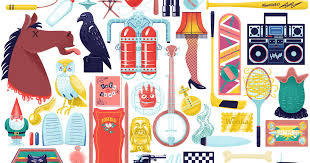
Experimenting with different font styles can infuse character into your work. you will be surprised by what an enormous change a seemingly small typographic tweak can do! Originally an style of architecture , the brutalist aesthetic is one that's characterized by deliberate plainness or crudeness. Brutalism has made a comeback in many realms today, and you'll now find the design in fashion, furniture, and, more and more frequently, graphic and web design. When brutalism is employed in graphic design, the aesthetic is one that grabs your eyes with its rawness and unpolished nature.
Typefaces during this style substitute stark contrast to the fashionable neat, polished look that so often encapsulates contemporary design. If you're trying to form your design projects a touch weird (or unique), inspect these 20 brutalist, reverse contrast typefaces. they are not your typical clean-cut body fonts, but ultimately, they will make your text more interesting and obtain more eyes noticing your creations than ever before.
Adele Moon
For a font with a definite artistic movement feel, try Adele Moon, created by Roselyn Carry. The typeface comes with 22 different ligatures with common letter combinations, and therefore the designer has also included9 pre-made logos that match the typeface's aesthetic as a bonus. The typeface is somewhat whimsical in feel, with curled ends and little , decorative serifs. this is often an honest choice of typeface for branding, titles, and logos.

Astoria
TanType created ASTORIA, a display typeface that features a mythical or antique feel. The designer of ASTORIA describes it as a "quirky display serif that spells fun" with a "psychedelic look." this is often definitely not a body font, but one that's best fitted to mastheads, posters, branding materials, and more. Because the serifs on this typeface are so slight, it pairs well with most convention serif or Helvetica fonts.

Hacky
For a font that exudes luxury, choose Hacky, created by madeDeduk. The font comes with 9 variable weights, also as uppercase characters, lowercase characters, numbers and symbols, international glyphs, uppercase alternatives, lowercase alternatives, and ligatures.
Hacky is a superb font to use for branding or packaging materials, and therefore the designer also suggests using it on an "invitation....t-shirt, label, poster, logo, etc." One perk of selecting this font is that you simply can visit the designer's Instagram to ascertain samples of what the typeface seems like within the world

Ethery
Another font compatible for luxury brands is Ethery created by LABFCreations. This stylish, symmetrical font is contemporary in feel, but its classic, minimalistic look makes it an honest fit any project with a clean, sleek aesthetic. The designer explains, "Geometric and classy , this font is right for creating logos and branding. With original ligatures...It works perfectly for creating stylish logos, striking editorials, invitations, graphic quotes, and more" once you purchase Ethery, you'll receive OTF, TTF, WOFF, and WOFF2 files with the font. there's also multilingual support for various languages.
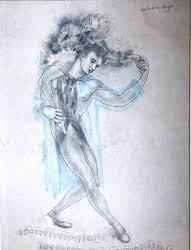
Kendrick Serif
Kendrick Serif may be a distinctively fun font with a bold look—perfect for headlines and branding. The typeface was designed by Jeremy Vesey of Hust Supply Co. It comes with 362 glyphs and regular and oblique versions of both the uppercase and lowercase set. once you download Kendrick Serif, you get TTF and OTF files, a Webfont kit, and western European characters.
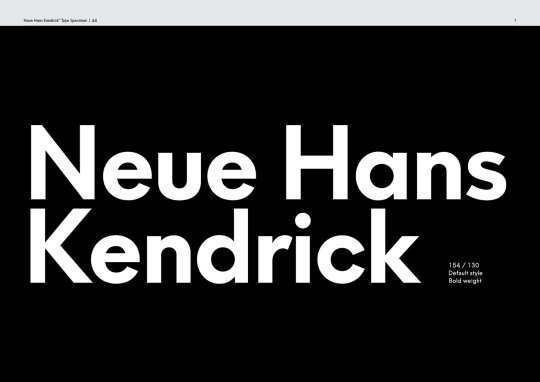
Valky
From NEWFLIX.Bro may be a serif typeface with a vintage feel, and it's perfect (according to the designer to be used in "editorial projects, Logo design, Clothing Branding, product packaging, magazine headers, or just as a trendy text overlay to any background image. once you download Valky Classic, you get a bunch of fun features, like 4 font weights, lowercase and uppercase, stylistic alternatives and ligatures, numerals, punctuation, accented characters, and support for multiple languages. one among the good parts about Valky is that the designer is hospitable suggestions and welcomes requests for extra glyphs and language support.

Evangelina
One of the fanciest, most intricate fonts on the list is Evangelina: a typeface created by designer New Tropical Design. The designer explains that it's intended to be a display font and designed as an ode to fashion photography from the 1970s to today. The font has elaborate curves and shapes, and since of its elaborate nature, it is best for headings, logos, invitations, and more. It's an attention grabbing choice of font, and it comes with OTF and web fonts, upper and lower cases, number, punctuation, and multilingual support. The designer of Evangelina says that it is a typeface that's "guaranteed to draw the eye!"

Bornice Modern Serif
Bornice Modern Serif may be a brutalist font with an unmistakable vintage aesthetic and just a touch little bit of cartoonish quirk. This font, which was designed by Damelev, has some interesting inspiration behind it, because the designer explains, that it represents "exuberance and faith in social and technological progress." Bornice was intended to be used for logos, t-shirts, apparel, badges, invitations, packaging, headlines, posters, magazines, greeting cards, wedding invitations, and more. you'll access its OpenType features on most Adobe programs, including Indesign, Illustrator, and Photoshop.

Cyrano
Dharmas Studio made Cyrano, a serif font where every letter was handcrafted to seem European and trendy . The designer created the font for fashion-centric projects. They suggest using Cyrano for "creating elegant, chic, lifestyle design like logos, title, magazine and more" The font comes with a lowercase that's actually uppercase and therefore the uppercase is alternate. once you download Cyrano, you get TTF, OTF, SVG, and Webfont versions; letters, numbers; punctuation, multilingual support, ligatures, and an alternate access guide.

Canyon
Canyon, created by Bnick, is a chic serif display font supported Henri Jules Ferdinand’s “Le Bellery Desfontaines” holotype . The designer explains, " I modified and refined each and each character (along with creating new ones) so as to be legible during a digital format." once you download Canyon, you get all English characters and punctuation, along side most Swedish and European characters. This font is obvious , simple, and straightforward to read, and it's slightly of character without adding anything too over the highest .

Milla Grace
From LABFCreations is Milla Grace, a thin, all caps elegant font that exudes classical beauty. The designer of Milla Grace explains that the font is right for logos and branding, also as "creating sites, logos, striking editorials, invitations, graphic quotes, and more." once you buy Milla Grace, you get OTF, TTF, WOFF, and WOFF2 files with each font. you furthermore may get uppercase characters, discretionary ligatures, and multilingual support for various languages.
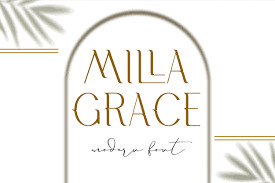
Tittowest
Haksen created Tittowest Futuristic Serif Display Font, which is best fitted to headlines, logos, posters, packaging, t-shirts, and more. This font is funky and industrial-feeling, and it comes with both uppercase and lowercase. once you download Tittowest Futuristic, you get both a daily and Italic version, alternates in uppercase, ligatures in lowercase, numerals and punctuation, accented characters, and more. Multiple languages are supported, and therefore the download comes with OTF, TTF, and WOFF files. The designer recommends using it in Adobe Illustrator or Photoshop with OpenType features.
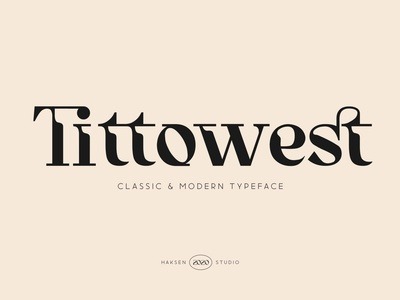
Pearl
Pearl may be a perfect name for this font from TanType because it feels elegant and female . With playful curves, the designer of PEARL explains that the font is supposed to "tease your eyes." Still, it also features a classy composition, fancy enough for elegant packaging, invitations, apparel, and other products that decision for whimsical, wavy fonts. The download comes with multilingual support and OTF, TTF, and WOFF files.

Cigra
Identitype created Cigra, a font that's fashionable and stylish but easy to read. The designer of Cigra describes the font as "a standout display font that's an ode to fashion typography in present day. Its elaborate curves and unique shapes make it perfect for headings, logos & wedding invitations." it's PUA Encoded characters that are fully accessible with none additional design software, and it includes multilingual support. Also, its Open type features are often access using Illustrator, InDesign, Photoshop, Word, and more. Indentitype sums up this luxury font perfectly, saying, "Cigra is all class, so if you would like a trendy font that's bound to draw the attention , then this is often it!"

Migaela
Migaela may be a fun, retro feeling font that was created by nurrontype. This display font features a distinct seventies-era aesthetic—with a fun little bonus - the dot of the i is formed of a snowflake! The designer of Migaela calls the font "cheerful, positive, and charming." once you purchase Migaela, you get three optional styles: regular, overlap, and smooth (rounded). think about using Migaela for a retro Christmas, winter, or holiday project because that snowflake detail is simply the wintry accent to enliven any wintertime project
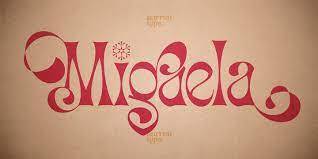
Kindred
Looking for a cool , retro feeling display type that harkens back to a special era? Try KINDRED by TanType. this is often one among the foremost distinctive of the reverse contrast typefaces on Creative Market, and its curvy lines and quirky look make it good for a 70s-style project—or one that harkens all the way back to Mythical times (Thinks: a Funny Thing Happened on the thanks to the Forum). The designer, TanType, says the font is well-suited for any project you've got in mind, and that they include the font utilized in a spread of settings within the product's screenshot on Creative Market.
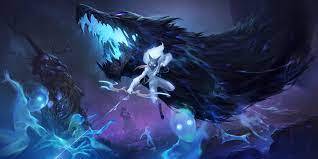
Holly Jolly Bundle
Annie Konst created Holly Jolly Bundle, an incredibly fun, brutalist type that's really well-suited for brand spanking new Years', Christmas, and winter projects. The font looks distinctly hand-doodled, and it pairs well with cartoon images or aesthetics. within the bundle, you do not just get the font. you furthermore may get tons of extras, including (according to the designer): "ready-made illustrations and PNG clipart for your projects, just take it and use!" one among the simplest parts about the bonus elements is that they're also editable in order that you'll fit them into your projects, and you'll work with these elements in Illustrator, Photoshop, or Canva.

Eclipse
Eclipse may be a classic, condensed serif typeface made by Studio Aurora. The font is best fitted to display-type projects, and therefore the designer recommends using it within the following projects: "magazines (titles and layouts), logos and branding, invitations, social media, quotes, blog headers, posters, and advertising." The font has language support for several languages, including Afrikaans, Albanian, Catalan, Danish, Dutch, English, French, German, Italian, Norwegian, Portuguese, Spanish, Swedish, and Zulu. This strange eye-catching font may remind you of watching the moon because it changes the form of their month.
Explore More Brutalist Typefaces
Brutalism is more popular than ever, thanks, perhaps, to a backlash to the sleek, clean minimalism that dominated the last decade. If you would like to require advantage of a design trend that's popular, eye-catching, and different than what most of the people have seen in recent years, consider incorporating some brutalist elements into your creations—particularly when it involves typefaces. These brutalist fonts draw eyes to projects and are unforgettable—helping your project draw attention and make an impact on anyone who encounters it. For even more eye-catching, unforgettable designs, flick through all of the planning assets on Creative Market. because of the designers on Creative Market, the location is full of plenty of resources to assist make your work one-of-a-kind—particularly creative typefaces and retro fonts, get start your course for knows the facts of graphic designing find the best institutions which have the graphic designing course in Delhi.
Choose one among the brutalist fonts above, or browse the remainder of the location to ascertain logos, templates, icons, graphics, photos, and more from designers which will infuse just the proper amount of character into your project. you will be happy to understand that Creative Market designers have mastered every aesthetic—from wondrous to weird, and you will be ready to find many elements to form your projects look even more professional and aesthetically pleasing than ever before.

1 note
·
View note
Text
Pearls have always been a symbol of elegance, but until now, most women have had a rather conservatory approach towards them. This year, major fashion taken a modern approach to pearls with bold designs and refreshing collections.
In this article, we are going to show you 10 ways to style and wear your authentic pearls, proving that they are not only meant for formal events and can easily be incorporated into daily outfits.
Black & White Rings with Monochrome Outfits
Image Source: Pinterest
The inspiration for this outfit comes from none other than Beyoncé. Queen B stole the show during the 2013 Grammy Award’s with a minimalistic hot black-and-white jumpsuit. What can you take away from this outfit? Less is always more. Monochromatic outfits work very well for business casual and formal settings. They can also be styled easily with statement and pearl jewelry. We strongly recommend accessorizing real pearl rings, either Akoya or Tahitian, with classic studs, stilettos, and monochromatic jumpsuits or office ensembles.
2. Statement Pearl earrings with Bold Sequins
NEW YORK, NY – SEPTEMBER 10: Model Taylor Hill walks the runway for Prabal Gurung fashion show during New York Fashion Week: The Shows at Gallery 2, Skylight Clarkson Sq on September 10, 2017 in New York City. (Photo by Frazer Harrison/Getty Images For NYFW: The Shows)
Statement earrings are big this season. Major fashion houses are incorporating over-sized pearl earrings into daring outfits. A perfect way to wear statement pearl earrings is by combining them with bold sequin blouses or dresses. Bam! You have not one, but two powerful accessories that complement each other perfectly. You need nothing else. Simply pull back your hair in a sleek hairdo to emphasize the earrings and neck-line and you’re set.
Image source: Frazer Harrison/Getty Images
3. Turn your necklace into a bracelet
We challenge you to take your grandmother’s forgotten pearl necklace and turn it into something amazing. Long necklaces can easily be styled into multi-stand bracelets. All you have to do is to wrap it around your wrist for a few times until it fits. Combine with a simple jumpsuit or a short dress for the perfect summer look.
4. Ribbons on Pearl Jewelry
Want to repurpose your pearl jewelry without damaging it? A simple ribbon is the answer. You can get a silk ribbon which will actually protect the pearls and wrap it around the necklace or a bracelet. Look for a colorful ribbon and combine it with black or white pearls. You can even create a set by adding ribbons to your pearl earrings. This type of necklace works extremely well with classic cut dresses and cocktail outfits.
Image source: lonestarsouthern.com
5. Silver Necklace with Pearl Pendant
Silver necklaces are amazing because you can wear them with any outfit. Also, they are pretty easy to combine with other pieces of jewelry, especially with pearls. For this style you will need two or three long silver necklaces of different lengths and a simple pearl pendant. Choose a black pearl to add a bit of mystery to your outfit or combine with a velvet choker. We strongly recommend wearing this type of jewelry with simple V-cut blouses or dresses.
6. Delicate pearl Headbands
You don’t have to wait for your wedding day to wear a delicate pearl headband. There are countless ways to style headbands because there are hundreds of models of headbands that you can choose from. From casual, to boho chic, and even burlesque, pearl headbands are always appropriate. You can mix different pearl colors with flowers, silver accessories, floral motifs, and luxury materials. The image below is a perfect example of pearl headband incorporated into a casual summer outfit.
Image Source: Pinterest
7. Earrings styled as a Brooch
A pair of interesting pearl earrings can also be used as a brooch. You can place them on your favorite dress, t-shirt or jacket. Just use the pin and catch it on the material. Then close the pin with the special lock and your will have an amazing brooch that gives you a more feminine aura.
8. Reversed Long Pearl Necklace
The perfect look for a relaxed dinner date can be achieved with a maxi dress with flower prints and a backdrop pearl necklace. Get a backless dress and your favorite long pearl necklace and give your look a twist. Instead of wearing the necklace normally, let it swing on your back for a more dramatic appearance or purchase a backdrop necklace designed specifically for this purpose.
9. Black and White Jewelry
Another interesting way to style your pearl jewelry is to select two pieces of jewelry and combine them. Get a black necklace and a white one. Combine them, adjust strand sizes and you will get a special piece of jewelry for a classier occasion.
Image source: Pinterest
10. Play with Multicolor Pearls
Pearls don’t just come in black and white, they can also be lavender, pink, or golden. As far as colored pearls are concerned, none are more fabulous then colored baroque pearls and golden south sea pearls. All baroque pearls have a unique shape and incredible luster. You can buy the most interesting colored baroque pearls and create your own long necklace to wear at work.
Image Source: Pinterest
Choose any of these styles if you want a modern and interesting way of wearing your pearl jewelry. Make sure to combine these gems with appropriate clothes. Go for simple patterns so your outfit looks amazing.
10 Unique Ways to Style Authentic Pearls Pearls have always been a symbol of elegance, but until now, most women have had a rather conservatory approach towards them.
0 notes
Text
How to Overcome Self-Doubt
Your life is not about you. Your life is about everyone else whose life you touch.
Neale Donald Walsch
If you have ever doubted yourself, welcome to the club. To be human is to doubt yourself. It feels totally natural to keep comparing ourselves with others and adopt one set of standards or another in which you always fall short. You don’t match other people’s standards. You don’t match your own standards. Whatever your age, whether 19 or 69, you imagined you would be a lot further along than you actually are. Why are you so unforgiving to yourself? You would never be that way to your own family, or even your pet, so why keep beating up on yourself?
If Only I Hadn’t Totally Messed Up…
We lock into self-doubt through well-timed, clever excuses that conveniently explain why we aren’t up to par. While these excuses are often based on legitimate concerns, they have little or nothing to do with our future. We all have messed up in various ways, some more than others. None of us are where we thought we would be as a child. Messing up can take the form of blowing a relationship, failing a class, losing a job or even reversing a career. Sometimes it might entail serious bodily injury or harm and damage to other people. It might even result in our being temporarily incarcerated. Even more insidious, messing up can take the form of hard-to-kick habits, such as illegal drugs, alcohol, indiscrete sex and the like. Because you have such a hard time smoking, it certainly proves you are a loser. Or does it?
If Only I Had the Time and the Money…
The most popular forms of victimization are a lack of time or money. Who doesn’t feel constraints on their income and investments, the amount of years left in their life, the percentage of time in their day that is truly discretionary? While we all have 24 hours in a day, some of us are not only broke, we are deeply in debt. Our financial worth has cratered. Many of us with mortgages feel like slaves, working harder than drug pushers to break even. Many of us just live from paycheck to paycheck. God help us should there be any kind of disruption in the pipeline! However, who you are is outside of time. The way you handle time and money says a lot about how skillful you are in the world, as well as lucky. Whether you have all the time in the world or no time to smell the roses has nothing to do with Who You Really Are.
If Only I Knew What I Wanted…
The most legitimate excuse you can ever come up with is that you don’t really know what you want. Even if you have finally figured it out, you didn’t know what you were doing in your formative years. Welcome to the club. Few of us are like Steven Spielberg who knew at 12 years old that all he ever wanted to do was be a famous film director. Few of us at 33 can join Alexander the Great in claiming that we’ve conquered the known world. You don’t know what you want, because you are trying to live someone else’s life. You have bought into all the images, not only in Hollywood, but in the social networks and media. Almost everyone would like a glass house on a hill in a forest by the sea with a brand new Tesla, a private Lear Jet and a convenient helicopter… just for mischief.
You want a trophy husband or wife, not because they are so loving, but because they make you look good in your advancing years. Have you ever figured this out? You always want what you don’t have, or can’t have. If you really did get it, how long would it do it for you? You might like to live in a mansion, but do you really want to maintain it? Not just the time and the money, but the hassle?
Know Who You Are: Fully Human, Fully Divine
If only you knew who you really are, you would never again doubt yourself! Yes, you are human, fully human, but you are also divine, fully divine. This defies common sense! We might imagine that we could be half-human and half-divine, but certainly not fully both! Strangely enough, this is exactly what theologians concluded about Jesus Christ. The religion erected around Him is all about becoming sons and daughters of our Creator, isn’t it? As a son or daughter of God, you are fully human and fully divine at one and the same time. As Dr. Deepak Chopra likes to point out in his classic, How to Know God, the divine nature is literally hardwired into your nervous system, associated with the seven chakras. Your Divine Self is literally built into you. Being human places limits on almost everything. Being divine means no limits whatsoever. Being human, you can do a few things well. Being divine, you can accomplish whatever you truly want, because you are infinite. Everyone and everything is part of your Big Self, Who and What we call “God” and the “Universe.” You are Source individuated as a uniquely precious incarnation. You are spirit having a bodily experience for a time.
Know What You Really Want: To Make a Difference
When you grow sick of accumulating status symbols, when you are tired of proving yourself to people who don’t really care for you, anyway, you will realize what you truly want in life. Yes, you do want to have your basic needs met, so that you are no longer preoccupied with them. You want far more to go beyond them to contribute to the world and society in massive ways. How many world tours would you take before you became weary of the whole act, especially if you only hit the five-star hotels and the tropical beaches? After a certain number of toys, you would want to start doing something truly worthwhile. Once you found your dream partner, you would want to do something with the relationship. Even an idyllic relationship is but a launching pad. Why do you think so many billionaires have turned into philanthropists, such as Richard Branson and Bill Gates? Even if you think of Donald Trump, why did he give up a life of ease hopping from one gorgeous hotel to another to do something as crazy as try to save the American economy? Because having all the time and money in the world won’t fill your soul. You want to change the world, and you want to change it now (for better or worse).
Create a New Possibility and Live Out of It
How then can you make a difference? How can you shift over from preoccupation with your small self to your Big Self? When you start to throw your attention off yourself onto others to actually serve them, you will begin to discover a form of happiness that no one and nothing can ever take away. You will stumble on divine love. Just think of Albert Schweitzer, a great theologian and a concert organist who chose to leave Europe to become a missionary in Africa. You create a new possibility from within you by declaration alone. You look out at the world and see how things can be different, whether it is in the U.S. normalizing relationships with both North Korea and Russia, saving the ice caps or establishing animal rights. You are no longer deterred by how impossible these goals may seem. You declare it as a possibility and begin to live it. You invite others to join you. Eventually, the Universe aligns with our vision.
If you think of all the great people who have blessed the earth, from Buddha to Jesus Christ to Mahatma Gandhi, to even Steve Jobs, they have all had moments of doubt, every one of them. But they refused to wallow in their doubts. They had a higher vision that they were utterly committed to see realized on this planet, regardless of the consequences. And the rest is history.
The post How to Overcome Self-Doubt appeared first on ConsciousOwl.com.
0 notes